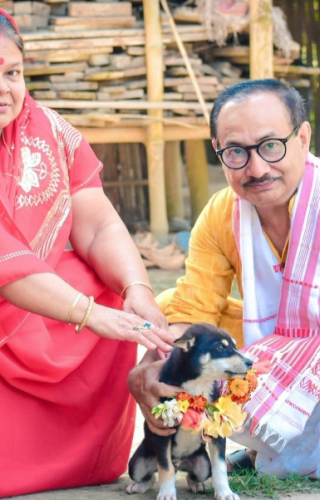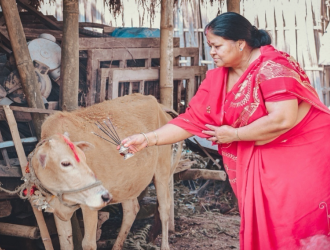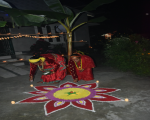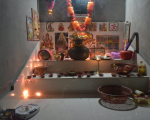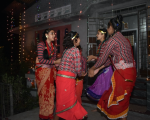The celebration of Diwali in the Nepali community of Assam starts from trayodasi tithi (thirteenth day) of Krishna-paksha (the dark half of moon) in the month of Kartika(Oct–Nov) and goes on until dvitiya tithi (second day) of sukla-paksha (the bright half of moon). This five-day Diwali festival is also known as Tihar Parva in the Nepali community of Assam.
According to the Hindu sastras, Suryaputra (son of Lord Surya) Yamaraja (god of death) was invited by his sister Yamuna to her home on the first day of Diwali. Yamuna took care of Yama for five days; Yama was pleased with this and granted his sister a vardana (boon): Yamuna asked that every brother visit his sister on this day of the year, and that they pray for the well being of each other, exchange love and affection, and make their bond stronger. Pleased with Yamuna’s demands, Yama conferred the boon. Following this tradition, the Nepali community celebrates the festival for five days.
The first day of Tihar Parva is known as kauri tihar (crow tihar), the day on which people offer food to crows; on this day, the Nepali people of Assam eat only after offering some food in the name of crows which they keep in the open. The crow is considered to be the vehicle of Yamaraja, and the Nepali community believes that on this day the crows bring the news of the arrival of Yama to earth.
The second day of Tihar Parva is kukur tihar (dog tihar); the day is also known as narakacaturdasi (naraka means hell) because it is believed that on this caturdasi tithi (fourteenth day) of Krishna-paksha in Kartika, Lord Sri Krishna killed the demon Narakasura and brought peace in this world.
The third day of Tihar Parva, which is the amavasya (new moon) day, is considered to be the most important and is reserved for Goddess Lakshmi’s worship. During the day, people worship cows and, in the evening, they light diyas and decorate their households with light to worship the goddess of wealth, Lakshmi. Once Lakshmi worship is complete, people perform bhoili song and nritya (dance). Generally, the girls perform the bhoili song and dance in honour of Bali, the king of demons. In this way, by performing bhoili song and dance, people enjoy this auspicious night as they forget their worries and pains. The singing and dancing stretches over to the next two days as children make merry while women prepare seal roti (a type of bread). Since the Nepali community in Assam also shares the belief that on the third day of Tihar Parva Lord Ram returned to Ayodhya after defeating Ravana and took charge of his kingdom, people light diyas at night to celebrate his victory and also call Diwali, Deepavali (the festival of lights).
The fourth day of the festival is known as Govardhana puja. On Govardhan puja, people make cow dung hillocks symbolising the Govardhana mountain (mountain of food) and perform various rituals, including the worship of damora(male calf) and bulls.
The last day of the festival is known as bhratrdvitiya. The day starts with people making a sand structure in front of their houses after which women perform Yama puja, keeping Surya (the sun) as witness. For Yama puja, women break a betel nut near the threshold of the house with a grinding stone to please Yama. Bhratrdvitiya is significant for siblings, and involves bhai tika (tilak) where women pray for their brothers’ well-being and paste a tilak on their forehead.
